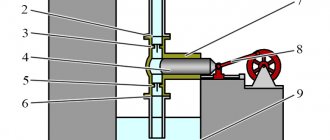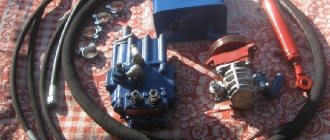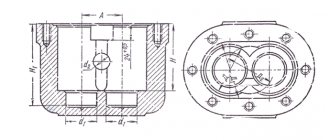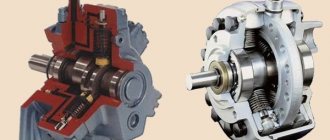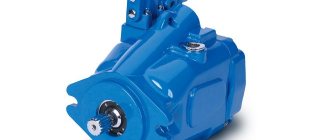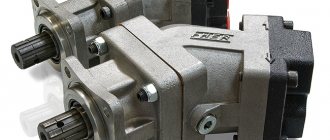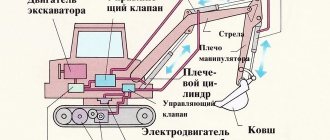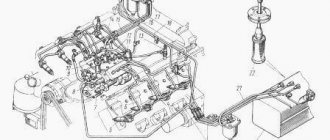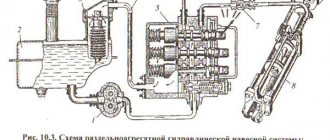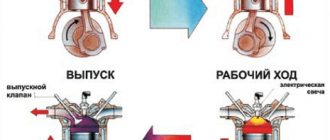Schematic diagrams of axial piston hydraulic machines
An axial piston pump is a technical device that belongs to the category of hydraulic machines, the mechanical energy of the working body of which is converted into the energy of a moving fluid flow. If such machines perform the opposite action (in other words, the energy of the fluid flow is converted into mechanical energy), they are called hydraulic motors. Both hydraulic motors and hydraulic pumps began to be used quite a long time ago, and today they are actively used almost everywhere.
Axial piston pumps are installed on dump trucks, bunker trucks, multi-lifts and other equipment
Axial Piston Hydraulic Pump A hydraulic motor is one of the types of rotary piston hydraulic machines.
a brief description of
The inventions are widely used in industry and agriculture because they can withstand enormous overloads.
Hydraulic pumps and motors are found in technical enterprises and are used to supply water to areas, houses and apartments. There are known cases of the introduction of these machines during the construction of spaceships. Hydraulic units operate under the influence of changes in the size of the working surfaces. The latter have a direct connection with the outgoing and incoming pipes. Chambers and pipes are connected gradually and sequentially, through strictly designated time periods. Devices of this type of action have specific names:
- Axial piston pumps.
- Gear hydraulic machines.
- Piston pumps.
- Screw hydraulic units.
You should definitely read about what sizes the M12 bolt comes in.
Conclusion
There are many types and designs of hydraulic motors, and the majority of types have an analogue in design with hydraulic pumps.
A hydraulic motor is a special device that is necessary for the energy of the fluid to be converted into fur. energy, and after this process it must still act on the input shaft. And the shaft affects the operation of the entire machine and performs various technological functions. This small mechanism is capable of performing many transformations and has good performance properties.
Hydraulic motors are used everywhere, namely in agriculture, the oil and gas industry, aviation and many others. Hydraulic motors come in a variety of types, each type has its own advantages and disadvantages.
The choice of a particular hydraulic motor is based on their main characteristics and design. In the modern world, where there is a struggle to improve the environmental situation, much attention is paid to hydraulic motors that have the least impact on the deterioration of the environmental situation.
Advantages and disadvantages
An axial piston hydraulic motor and hydraulic pump of this type, when compared with radial and steam devices, have the following advantages:
- With a fairly compact size and light weight, such devices have impressive power and decent performance.
- Due to their compact size and light weight, pumps of the axial piston type create a small moment of inertia during operation.
- The rotation speed of the output shaft of an axial piston hydraulic motor is very easy to adjust.
- These devices operate effectively even at a sufficiently high pressure of the working fluid and at the same time create the appropriate torque of the output shaft.
- In such installations, it is possible to change the volume of the working chamber, which cannot be achieved when using hydraulic pumps and radial piston hydraulic motors.
- The frequency with which the output shaft of hydraulic motors of this type rotates, depending on the model, can be in the range of 500–4000 rpm.
- Unlike radial piston pumps, which can operate at a working fluid pressure not exceeding 30 MPa, axial units are capable of operating at a pressure reaching 35–40 MPa. In this case, the loss of such pressure will be only 3–5%.
- Since the pistons of axial pumps are installed in the working chambers with minimal clearances, high tightness of such installations is achieved.
- When using pumps of this type, both the direction of flow and the pressure of the working fluid can be adjusted.
Read also: Speed controller of the commutator motor from a washing machine
Adjustable axial piston hydraulic motor used on loaders, excavators and truck cranes
Like any other technical device, axial piston pumps have disadvantages:
- Such pumps are quite expensive.
- The complexity of the design makes it much more difficult to repair axial piston hydraulic pumps.
- Due to the not very high reliability, hydraulic mechanisms of this type should be operated only according to the instructions, otherwise you may encounter not only the low efficiency of such a device, but also its frequent breakdowns.
- When using pumping equipment of this type, liquid is supplied to the hydraulic system with large pulsations and, accordingly, is consumed unevenly.
- Due to the high pulsation characteristic of the operation of such pumps, the hydraulics with which the pipeline system is equipped may not work correctly.
- Hydraulic mechanisms of the axial piston type react very critically to a contaminated working environment, so they can only be used with filters whose cell size does not exceed 10 microns.
- Axial-piston hydraulic devices, due to the peculiarities of their design, produce significantly more noise during operation than models of pumps and hydraulic motors of the vane and gear type.
The axial piston type, as mentioned above, can include not only hydraulic pumps, but also hydraulic motors. The operating principle of the hydraulic motor is almost identical to the operating principle of an axial piston pump. The main difference is that such work is performed in the reverse order: liquid is supplied to the device under a certain pressure, which forces the pistons of the hydraulic motor to move, causing its output shaft to rotate.
Design and principle of operation of a circulation pump If you don’t know what the principle of operation of a circulation pump is,...
How to choose a pump for a pool: a comparative review of different types of units. You want to equip your own pool by creating…
The simplest pump from plastic bottles A simple pump for pumping liquid can be made in just a few minutes...
Hydraulic pumps today are widely used in a wide variety of industries: from households to mechanical engineering. Due to their high performance characteristics, they are used to provide water supply to private and apartment buildings, supply fuel to equipment at industrial enterprises and space stations. The most common are axial piston-type hydraulic pumps.
Read also: Gates made of corrugated sheets drawings
Characteristics and their influence
Main characteristics of hydraulic motors:
1.Rotation speed (rpm):
Only a few hydraulic motors can be successfully used simultaneously in the range of very low speeds and at speeds above 1000 min-1.
In this regard, hydraulic motors are divided into high-speed (n = 500... 10000 min-1) and low-speed (n = 0.5... 1000 min-1).
2.Torque
The torque developed by a hydraulic motor depends on its working volume and the pressure difference in the cavities.
Low-speed hydraulic motors already develop high torques at low speeds.
3.Developed power
The power developed by the hydraulic motor depends on the displacement and pressure drop; it is directly proportional to the rotation speed.
Thus, high-speed hydraulic motors are well suited for powerful hydraulic drives.
Hydraulic motor influence
The hydraulic motor is an actuator, therefore it is required to have high speed or efficiency (at nominal operating conditions), linearity of characteristics in the zone of low shaft rotation speeds, or stable operation of the hydraulic motor at a given minimum speed.
Systems with proportional control are very common among stabilization and guidance drives. They are characterized by the fact that the speed developed by the hydraulic motor is, to a first approximation, proportional to the mismatch signal between the input and output of the system, and the closer the control object is to the agreed position, the lower the speed.
For many hydraulic motors, friction in the running parts is a significant and determining nonlinearity at low shaft rotation speeds.
Pros and cons of an axial piston pump
The structure of such hydraulic machines has a main difference from other devices: here the working chambers, located in a cylindrical block, have the form of barrels with a spiral thread. The compartments are located axially (parallel) to the piston system and the main axis. These barrels change their volume due to the fact that the reciprocating parts move in the chambers. As a result, water is sucked in or released during operation of the unit.
- The advantage of the axial piston device is its low weight and compact shape with sufficient energy capacity.
- The operating principle of the design is due to low inertia, since the parts of the unit have small dimensions.
- While using the machine, it is possible to change the rotation speed. They are designed in such a way that they can perform work under dangerous pressure (35 to 40 MPa).
- The rotation range of axial piston pumps varies from 500 to 4,000 rpm. These figures are significantly higher and wider than those of hydraulic motors or radial piston devices.
Negative characteristics include the following among designers and workers:
- Due to the above advantages, the unit is expensive.
- Axial piston pumps are designed according to rather complex drawings.
- If the machine is not used according to strict operating rules, frequent breakdowns are possible. Repairing an axial piston pump is expensive and will take a long time.
- During operation, high energy consumption and significant pulsation of flow and pressure are noted throughout the entire area of the unit.
Types of hydraulic pumps - classification of units on the market
According to design features, purpose and areas of operation, there are the following types of hydraulic pumps:
- Manual ones are inexpensive devices that work on the principle of displacement. A hand pump does not have high performance and can only cope with the simplest tasks in the household;
- Radial piston - their design includes an eccentric shaft or rotor. The entire piston group of such units is located inside their housings. Among the advantages of these systems, low noise levels and the ability to operate under high pressure conditions of up to 100 Pa should be highlighted. Among the disadvantages are the large dimensions;
- Axial piston - these pumps use a plunger displacement system. This type includes inclined and straight pumps. Among the advantages of such systems is the highest performance among all types of equipment. Disadvantage: very high cost;
- Gear - this type includes units with electric drive. The main hydraulic element is made of two gears, which, as a result of clutch, squeeze out fluid. Pumps of this type are not capable of operating under high pressure conditions, but their cost is much lower than the units of the two previous types.
Most modern water pumps are often used in large farms. This allows owners to save a lot of time when collecting and pumping clean and recycled liquid.
What is an axial piston type hydraulic pump?
An axial piston hydraulic pump, like a radial piston one, is a positive displacement device that operates by changing the volume of the working chambers. In hydraulic pumps of the axial piston group, such working chambers are formed by borings, which are made in a cylindrical block. Unlike radial piston pumps, axial piston machines have internal working chambers located parallel to the pistons and the axis of the device itself. As the pistons of such a pump move and the cylindrical block rotates, the volume of the working chambers increases or decreases, which allows the device to suck in and release the liquid it pumps.
Tests
All hydraulic motors must be tested. The main ones are the removal of volumetric and mechanical characteristics and, in other cases, characteristics of noise and service life.
In order to determine all the parameters that characterize the operating mode of a particular type of hydraulic motor, stands are used. The stands are specially equipped with control and measuring systems and instruments for visual reading of the value being monitored, and they also use recorders or oscilloscopes to record all work processes.
The choice of control and measuring equipment, its location, the accuracy and type of instruments depend on the goals and objectives of the tests performed - all this is determined by the program and various test methods.
Axial piston pump: operating principle and structure
The cylindrical main block houses a system of pistons and connecting rods connecting the crankshaft and the reciprocating part. The design also includes distribution devices and stop disks. Since the cylindrical block is placed in the unit tightly pressed to the distribution mechanism, this allows problems to be avoided in most cases.
- The operating principle of the pump is based on the rotational movements of the drive shaft, which transmits impulse to the area of a specific cylindrical block.
- Next, the pistons begin reciprocating movement towards the main axis.
- The frictional force in such a system generates suction and then expulsion of liquid elements.
There are special holes in the distribution device that serve as a kind of plane for the interaction of opposite lines of work. Jumpers inside axial piston pumps provide greater reliability for specific openings. Throttle grooves placed on jumpers (mounts) are designed to reduce hydraulic shock on component parts. These elements allow the machine to smoothly increase the operating pressure inside the unit.
Design features and principle of operation
The axial piston type hydraulic pump consists of the following elements:
- pistons, also called plungers, which are part of the cylinder block;
- connecting rod type elements;
- drive shaft, which is also called the main shaft;
- mechanism that performs distribution functions.
Design of an axial piston pump with an inclined block
The principle by which an axial-type piston hydraulic pump operates is based on the fact that its main shaft, when rotating, imparts movement to the elements of the cylinder block. The rotation of the main shaft of axial piston type pumps is converted into reciprocating movement of the pistons, performed parallel to the axis of the cylinder block. It is due to the nature of such piston movements, which are axial, that the pump got its name.
Operating principle of an axial piston hydraulic pump
As a result of the movement performed by the pistons in the cylinders of the axial plunger pump, alternate suction and subsequent injection of liquid occurs through the corresponding nozzles. The connection of the working chamber of the pump with its suction and discharge lines occurs sequentially, using special windows made in the distribution mechanism. To minimize the risk of malfunctions during the operation of the cylinder block of axial-piston type hydraulic pumps, as well as to ensure reliable operation of such a device, its distribution mechanism is pressed as tightly as possible to the cylinder block, and the windows of such a block are separated from each other by special sealing gaskets. Throttle grooves are made on the inner surface of the windows of the distribution mechanism, the presence of which makes it possible to reduce the amount of hydraulic shock that occurs in the pipeline system during pump operation. The presence of such grooves on the inner surface of the windows of the distribution mechanism helps to increase the pressure of the working fluid created in the cylinders as smoothly as possible.
As it becomes clear from the above-described design of an axial piston hydraulic pump, its working chambers are cylinders located parallel (axially) to the axis of its rotor, and the displacement of liquid from such cylinders is carried out due to the reciprocating movements of the piston.
Pump operating principle
Displacers in axial piston machines can be pistons or plungers .
Read also: Making a machine for sharpening drills at home: making a sharpener with your own hands
Pumps with plungers are sometimes called axial plunger . However, often the names do not reflect this feature, and the pump is called axial piston , regardless of whether the displacer is a piston or a plunger.
In axial piston pumps with an inclined block, the axes of the working bodies are at an angle to the axis of the drive shaft. This angle determines the stroke of the pistons. Its value is less than 45°. In most designs, the angle of inclination is 20°-30°.
When the shaft rotates, the rotor or cylinder block is also driven into rotation through pistons pivotally mounted on the drive shaft.
The rotor is pressed against the spherical surface of the distribution disk, on which two crescent-shaped grooves are made.
When the drive shaft rotates, each of the pistons moves in the rotor holes. The amount of movement depends on the angle of inclination of the block.
When the piston moves, increasing the volume of the working chamber, liquid is sucked through the crescent-shaped groove and fills the chamber.
When the piston moves in the opposite direction, the volume of the working chamber decreases. The liquid is forced out through another crescent-shaped groove. The holes in the rotor in which the pistons move are evenly distributed. At that moment, while some pistons are displacing liquid, others are moving in the opposite direction. This ensures a continuous supply of pump fluid with significantly reduced pulsations.
In axial piston pumps with an inclined disk, the axes of the working elements are parallel to the axis of the drive shaft. The movement of pistons or plungers inside the rotor is ensured by an inclined disk on which the plungers rest through pushers.
The rotor is fixed to the shaft with a key, therefore, when the drive shaft rotates, the rotor rotates, and with it the plungers.
Read also: Simple potato hiller from an old bicycle: do it yourself
The plungers, when the drive shaft rotates, move in the rotor holes.
As the working chamber increases, liquid fills it. When the plunger moves in the opposite direction, liquid is forced into the pressure line.
NSh 10 – description of a popular model
The unit of this model is successfully used in the automotive industry, in the manufacture of tractors and other types of heavy agricultural equipment. It is often included in the design of domestic loaders and excavators created on the basis of tractors of the 1.4 tf class.
Among the main technical characteristics of the pump, the following should be highlighted:
- Working capacity – 10 cm3;
- Rotation speed – 3600 rpm;
- Maximum productivity – 11.5 l./min.;
- The nominal outlet pressure is 16 MPa;
- The maximum permissible pressure is 21 MPa;
- Weight – 2 kg;
- Efficiency indicator – 0.95.
Due to its high reliability and excellent build quality, this pneumohydraulic pump has proven itself well in industry. It rarely needs repairs and does not require regular maintenance.
Types of devices
Axial piston pumps come in two types.
The first includes products with an inclined washer. In the design of such devices, the crankshaft is combined with a cylindrical block, secured with bearings. The piston system is located in the area of the main chambers and rests directly on the swashplate. This disk and the axis of the tank with cylinders form a perpendicular to each other.
This angle allows the pistons to generate reciprocating impulses as the rotor begins to rotate. Consequently, the volumes of the chambers decrease or increase, which naturally provokes the absorption or release of liquid through the holes. In order to adjust this axial piston pump, the angle of the disc must be changed. Such units are used for medium and heavy load work.
The second type includes adjustable axial piston pumps with an inclined cylindrical block. The main difference between such a device and radial piston machines is that the drive, mounted on bearings, is designed in a T-shape. The cylindrical block rests on the second axis and is located at an angle to the main shaft. In the center of the structure there are parallel bores, inside of which there are pistons. The latter are connected to the main shaft using a connecting rod system.
The block communicates movement simultaneously with the start of rotation of the rotors. Thanks to the angle formed from the connection of the main lobes, some of the pistons extend beyond the rotor, while others enter. Thus, the liquid is pumped or reduced in the working chambers. Water, in turn, enters the cylindrical block through a special hole at the bottom and moves through the vessels inside the body.
On a note!
The design of an axial piston pump with an inclined block allows you to change the size of the piston stroke. This helps to vary the working volume in the chambers.
Lamellar
In these hydraulic machines, the plates placed on the rotor do the main work. Special springs strengthen their pressure against the stationary body. Adjacent elements become limiters of the volumetric chamber, in which the working medium, when the rotor rotates, enters from the supply cavity to the discharge cavity. The presence of two or more suction areas and the same number of entry zones into the system is characteristic of double- or multiple-acting designs.
You need to know: only single-action mechanisms can be regulated.
Advantages of vane pumps:
- Reduced pulsation.
- Reduced operating noise.
- Reduced requirements for contamination of the transported medium.
- Adjustable working volume.
Minuses:
- The rotor bearings are heavily loaded.
- Low pressure.
- Difficulty in sealing the plates at the ends.
- Low maintainability.
G12 is a popular brand of single- and double-flow plate structures.
Main varieties
According to its design, a piston hydraulic pump, like an axial-piston type hydraulic motor, can belong to one of the following categories:
- devices with a washer installed at a certain angle;
- axial piston pumps or hydraulic motors equipped with an inclined cylinder block.
The cylinder block of hydraulic motors and hydraulic pumps of the axial piston type, equipped with an inclined washer, is installed coaxially with respect to the drive shaft and is rigidly connected to it. The pistons moving in the grooves of the working chamber rest with their end surface on a washer, which is installed at an angle to the axis of the drive shaft. The principle of operation of such an axial piston pump is that when the drive shaft and swashplate connected to each other rotate together, the pistons of the device begin to move back and forth, thus reducing or increasing the volume of the working chambers.
When the volume of the working chambers begins to change, the liquid pumped through the pump is sucked in and pushed out. Devices with a swashplate are classified as adjustable hydraulic pumps, since by changing the angle at which the working surface of the swashplate is located, it is possible to change the flow parameters of the pumped liquid. Moreover, with the help of such a pumping device it is possible to reverse the water supply by changing the direction of the angle of inclination of the washer to the axis of the drive shaft to the opposite. Axial piston pumps equipped with a swashplate are installed in hydraulic systems operating under medium to high loads.
Schematic diagrams of axial piston hydraulic machines
The body of axial piston hydraulic pumps equipped with an inclined cylinder block has a V-shaped configuration, and their drive shaft is designed in the form of the letter T. The angle at which the cylinder block of the axial pump in question is located to the axis of the drive shaft can range from 26 to 40 °, and the number of pistons reaches 7 pieces. The operating principle of such an axial piston pump is as follows: when the drive shaft connected to the pistons through connecting rod mechanisms begins to rotate, the inclined cylinder block is also rotated, and the pistons located in the axial grooves begin to perform reciprocating movements, thereby reducing or increasing the volume of working chambers.
The process of suction and injection of the pumped working medium in axial piston pumps of this type is carried out through special openings-windows made in the distribution device, which is located motionless relative to the rotating inclined cylinder block. Unlike steam and radial piston pumps, in devices of this type the volume of the working chamber can be adjusted. This problem is solved by adjusting the angle of inclination of the cylinder block relative to the axis of the drive shaft using special mechanisms.
Axial piston pumps use a unified oscillating unit
Depending on how the design of an axial type plunger pump is implemented, it can be one of two types:
- In devices equipped with a double non-power cardan, full compliance of the angles measured between the intermediate, drive and driven shafts is achieved. When hydraulic pumps of this category operate, their shafts (drive and driven) move synchronously, which reduces the load on the cardan shaft, which, interacting with the disk, transmits torque.
- Axial piston type pumps have a design in which the pistons point contact with the surface of the inclined disk is implemented. This device does not have cardan and connecting rod mechanisms, which simplifies its design. The most significant disadvantage of axial piston pumps in this category is that to start them, it is necessary to force the piston elements out of the working chambers and then press their end part against the surface of the inclined disk. Meanwhile, due to the simplicity of the design, regular maintenance and repair of hydraulic pumps of this type is not very difficult.
Analysis of manufacturing companies
Given the wide range of application areas, it is not possible to conduct an analysis of manufacturing companies without taking into account the specific area of application (a huge number of manufacturing companies).
I can just say that there is a variety of Chinese manufacturing companies, such as Dongguan Blince Machinery & Electronics Co., Ltd., and there are Ukrainian ones, such as Stroygidravlika CJSC. There are Belarusian ones, such as Khorda-Gidravlika.
In Russia, hydraulic motors are produced as follows:
Closed joint stock company Hydraulic drives PSM, abbreviated name CJSC Hydraulic drives PSM. The company was founded in 2008. The company specializes in the production of hydraulic motors of the 310 series.
PPP GidroStanok LLC produces the following hydraulic motors: axial piston, gerorotor, gear, radial piston hydraulic motors.
In Omsk, one of the well-known manufacturers of hydraulic motors is OJSC Omskhydroprivod. Currently, the plant is one of the leading plants in the Russian Federation in the development and production of high-tech hydraulic units for the agricultural, tractor, road construction, municipal and other industries in mechanical engineering. Omskgidroprivod is a manufacturer of hydraulic motors of the planetary medium-speed series MGPK, MGP, MGPL, MGPR (produced under license from Danfoss (Denmark) series: RW, OMS, OMSS, OMSW) - the only manufacturer in the Russian Federation and neighboring countries;
On my own behalf, I can add that given the complexity of the design and the high cost of repairs, it is recommended to choose from large suppliers with a wide network of service offices.
Repair of equipment
The unit with closed holes is removed and washed with kerosene. Next, each individual pump element must be cleaned with a soda solution. To repair the holes of a cylindrical block, a special tool is used - a split cast iron lap. A mixture of diamond powder, oleic acid and stearin is applied to it. Pistons lubricated with industrial oil are processed without the use of abrasive pastes.
To restore the spherical surface of the cylinders, grinding is used on a specific machine. The end is restored by grinding the main holes with corundum stone and diamond powder. The work surface is repaired in the same way. When restoring the structure, you must make sure that all parts are cleaned of dirt and corrosion, and also lubricated with a special liquid.
Under the following circumstances, repair of faults is not possible:
- If the pump body, flange or door is cracked, dented or chipped.
- Deep scratches on the surface of the cylindrical block or the support axis do not allow repairs.
- If distortions are found on the connecting rods and pistons, restoration is impossible.
Technical characteristics of the model NSh 32
Most excavators are equipped with these pumps. Moreover, more than half of the excavators created on the basis of MTZ and YuTZ tractors have a pump mounted on the front circuit. This guarantees improved performance of the machine with bucket and bulldozer. Older chain tractors were equipped with NSh 32 pumps to ensure the operation of the bulldozer cylinders and supports.
For tractors created on the basis of MTZ, pumping equipment is responsible for the operation of the bucket, grab and boom.
Pump specifications include:
- Working volume – 31.7 cm3;
- The rated speed is 3 thousand rpm;
- Performance indicator at 1200 rpm. – 36 l./min.;
- Nominal outlet pressure – 16 MPa;
- The maximum outlet pressure is 21 MPa;
- Pump weight – 5 kg;
- Efficiency indicator – 0.95.
The unit of this model is characterized by high reliability and long service life. Thanks to this, it is actively purchased by foreign manufacturers of agricultural machinery.
NSh 50 – areas of application of the pump
This automatic pump is successfully used in the construction of road, agricultural and machine tools. It is often used in hydraulic systems operating at a pressure of 155 kgf/cm2. This model is currently produced by several manufacturers.
The products of each of them have many similarities in design and performance, but differ in size.
Pump specifications include:
- Working volume – 49 cm3;
- The rated speed is 3 thousand rpm;
- Rotation performance 1200 rpm. – 56 l./min.;
- The nominal outlet pressure value is 16 MPa;
- The maximum outlet pressure indicator is 21 MPa;
- Weight – 8 kg;
- Efficiency indicator – 0.95.
A hydraulic pump station equipped with such a unit will last a long time, regardless of the conditions and type of liquid.
